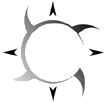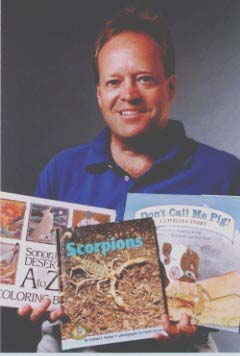![]()

Don't Call Me Pig! A Javelina Story
Author Interview with Conrad Storad:

I noticed that you have written many books regarding the Sonoran Desert and the animals that live in the desert. Is there a reason why your writing focuses on the desert and the vegetation and animals that are found there?
I have been a science writer and editor for the past 20 years. In that time I have written about research projects and topics ranging from Antarctic exploration to quantum chemistry to the neurology of zooplankton. The majority of my books for young readers have focused on Sonoran desert creatures and plants simply because these topics were of interest to various publishers. However, I love the Sonoran Desert. I love Arizona. I love learning about the desert and its living things. Being able to share with young readers a bit of what I've learned through the books I write is a special treat. Part of my job - as I see it - it to debunk the wealth of misinformation that circulates about the plants and creatures of the Sonoran Desert. Writing quality non-fiction that is fun to read is just one way of achieving that goal.I also noticed that you worked with the same illustrators, Beth Neely and Don Rantz, for your books, Don't Call Me Pig! A Javelina Story, and Lizards for Lunch: A Roadrunner's Tale. Were you aware of their illustrations before you collaborated on these books? Any particular reasons why these illustrators were chosen?
Getting a chance to work with illustrators Beth Neely and Don Rantz was just a matter of luck...very good luck. Actually, it was luck plus a case of "who you know." In the majority of cases, an author will never have a say in who is to illustrate a manuscript, let alone get a chance to actually meet and talk with the illustrator. In the case of Don't Call Me Pig! and Lizards for Lunch, the publisher was brand new. These are the first-ever titles published by Resort Gifts Unlimited of Tempe, Arizona. There was no normal publisher infrastructure in place. No in-house editor. No designer. No list of potential illustrators. The publisher relied heavily on me and my own contacts as a writer and long-time magazine editor to find a designer and illustrator for the books. A friend of mine was originally supposed to design the books. The illustrators lived around the block from her in Prescott, Arizona. Ironically, my friend did not end up being the designer for the titles. But the publisher and I both loved Don and Beth's illustration style. It was just what we were looking for to bring the text alive in these stories. We wanted realism, to a degree. We also wanted character, but not pure cartoon. Their work is all and more than I could have ever envisioned. I only hope to have the chance to work with them again in the future.Your book, Don't Call Me Pig! A Javelina Story, is a filled with information regarding javelinas. What type of research did you conduct before writing the book?
I always do extensive library research before I begin the writing process on any project, book or magazine article. I read scientific texts, journals, and other children's literature on a topic, if it exists. I also interview experts, particularly scientists and scholars who study the topics of interest. Working at Arizona State University as a science writer and editor of ASU Research Magazine, I have fairly easy access to a large group of experts on almost any subject. For this story, I found plenty of basic information about javelinas in existing books and magazines. I also gathered information from experts at ASU, the Arizona Game & Fish Department, the Phoenix Zoo, and the Arizona-Sonora Desert Museum. Several of the passages are the result of my direct encounters with herds of javelinas in the wild. I've seen and smelled them up close and personal on many occasions.What do you like most about being an author?
What I most love about being an author is the opportunity to learn lots and lots about all possible topics. Being a science writer is a dream job. As a teenager, I originally wanted to become a marine biologist or an entomologist. I ended up being a newspaper reporter and editor. Later on, I got the opportunity to blend my interest in science with my writing skills. As a science writer, I've had plenty of opportunities to write about marine biology and entomology, without having to be seasick or spend time in steamy jungles. However, I've also got the chance to write about much, much more, including geology, physics, chemistry, medicine, history, theater, fine art, and music. The really fun thing about being an author is having the ability to share what I learn through the books and magazine articles that I write. Learning and sharing is always satisfying on many different levels.What prompted you to become a children's author?
The answer is simple. I was asked. A publisher approached me and asked if I'd be interested in writing a book for young readers about the life cycle of a desert plant or animal. The result was Saguaro Cactus. That title was quickly followed by the books Scorpions and Tarantulas. The process for these projects was totally different from any kind of writing that I'd ever done before. I worked with talented editors. Writing for children is MUCH more difficult than writing for adults. But the process has made me a much better writer overall....I believe. In the years since that first book was published, I've worked with a large publisher, a small publisher, and have actually learned the ropes enough to be a self-publisher. As an author, there is always lots more to learn.What do you hope children/adults are able to get from your books? I hope that readers get several things from my books.
First, I hope that my words provide enjoyment at some level. I hope that my books are actually fun to read. I also hope that the information I provide might spark a bit of curiosity in the reader. I hope that they actually go beyond what I have written in the search for more. On a higher level, the goal is that my work might actually demystify a topic for a reader. I try to provide easy to understand and accurate information. If everything works the way I hope, my words may help the reader to have a greater respect and appreciation for the amazing world in which we live. If I can accomplish any one of these things with a child or an adult, then my work is a success.You visit Conrad Storad's Web site at: http://conradstorad.com/
You can e-mail him at: cstorad@asu.eduChain Reaction magazine is written and designed to show how scientists and scholars explore the world. Written for middle school students, Chain Reaction articles demonstrate the fascinating ways scientists and scholars create new knowledge. Click on this link to visit Conrad Storad's magazine Chain Reaction
This interview was conducted online on March 11, 2002. This page was updated on August 31, 2004.
About the Book | Book Review | Children's Voices | Interview | About the Reviewer